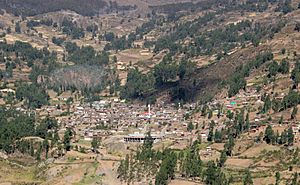Huari, Peru facts for kids
Quick facts for kids
Huari
Wari
|
|
|---|---|
|
Town
|
|
 |
|
| Country | |
| Region | Ancash |
| Province | Huari |
| District | Huari |
| Founded | 1572 |
| Elevation | 3,149 m (10,331 ft) |
| Population
(2018)
|
|
| • Total | 9,700 |
Huari is a small town located in the Ancash Region of central Peru. It's the main town, or capital, of the Huari Province. This town sits on the eastern side of the Andes mountains, specifically the Cordillera Blanca range.
The people in Huari mainly work in farming. About half of them grow crops to feed themselves and their families. They grow things like potatoes, sweet potatoes, quinoa, corn, wheat, and various vegetables. Many families also raise animals such as goats, sheep, pigs, and chickens. They even raise guinea pigs, which are called cuy in Peru! In this rural area, people often trade goods instead of using money.
Huari is connected to the electric grid, which means it has electricity. By 2005, some of the villages around Huari were also starting to get electricity.
History of Huari
Life in Huari in the 1960s
Back in the mid-1960s, Huari had its own way of making electricity. A small power plant used water from a stream to create power. This plant provided electricity from evening until morning. When morning came, the water was sent back into pipes to supply drinking water to the town.
At that time, fewer than 100 places in Huari had electricity and running water. This included businesses, government offices, some homes, the public school, and the local Catholic church. There were also less than two dozen streetlights.
Travel and Roads
Many streets in Huari were narrow, usually about four meters wide. They were made of cobblestones for cars to drive on. There were no paved streets made of concrete or asphalt. However, many streets had raised sidewalks also made of cobblestones.
Traveling from Huari to the west, towards the Pan-American Highway, was a long journey. It took about six to eight hours in good weather. The roads were made of packed earth and gravel until you reached the paved Pan-American Highway near the town of Comas on the Pacific coast.
To cross the Cordillera Blanca mountains, travelers used a special tunnel. This tunnel was about 800 meters long and only wide enough for one car at a time. It was a round tunnel cut through rock. The inside was rough, and water often dripped from the walls and ceiling, making the road muddy.
About halfway between the Cordillera Blanca and another mountain range, there was a north-south highway. This road connected Huari to Huaraz, the capital city of Ancash, and the ancient town of Recuay. A trip from Huari to Huaraz took about four hours by car.
See also
 In Spanish: Huari (ciudad) para niños
In Spanish: Huari (ciudad) para niños


